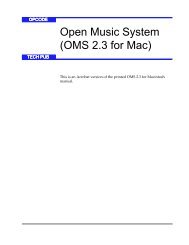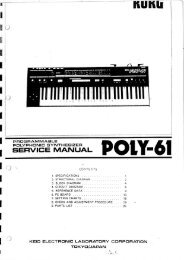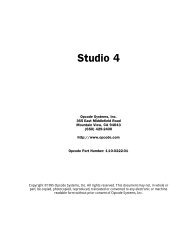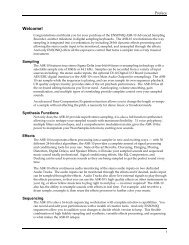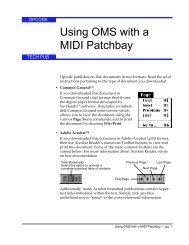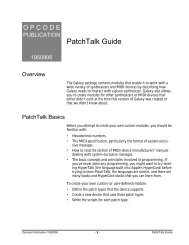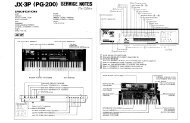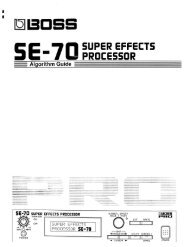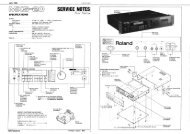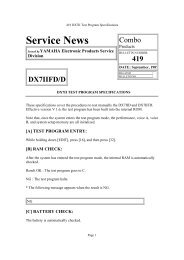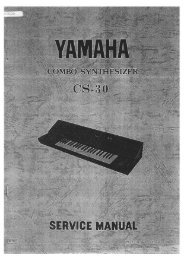Vision and Studio Vision Pro Version 4.1 Manual ... - House of Synth
Vision and Studio Vision Pro Version 4.1 Manual ... - House of Synth
Vision and Studio Vision Pro Version 4.1 Manual ... - House of Synth
You also want an ePaper? Increase the reach of your titles
YUMPU automatically turns print PDFs into web optimized ePapers that Google loves.
PART 3: The Acadia Audio System<br />
• Avoid trying to play lots <strong>of</strong> small<br />
audio events across many tracks, this<br />
makes disk access much less<br />
efficient.<br />
If a track has lots <strong>of</strong> audio events <strong>and</strong><br />
you are happy with the way it sounds,<br />
use the DSP>Mix comm<strong>and</strong> to write<br />
a single, contiguous audio event.<br />
In addition, use <strong>Vision</strong>’s File Management<br />
Window to consolidate audio files <strong>and</strong><br />
delete unused audio files. And, as always,<br />
make sure to regularly back up your data.<br />
RAM Resources<br />
The blue RAM bar in the Performance<br />
Window indicates the percentage <strong>of</strong><br />
<strong>Vision</strong>’s allocated memory that is in use.<br />
<strong>Vision</strong>’s available RAM determines the<br />
number <strong>of</strong> notes <strong>and</strong> audio events that<br />
can be recorded, <strong>and</strong> how <strong>Vision</strong> allocates<br />
memory for the digital audio’s Buffer Size<br />
(see page 85).<br />
To find out the number <strong>of</strong> available notes<br />
(events), click on the RAM bar for a popup<br />
menu.<br />
SCSI Interfaces<br />
For optimum disk performance, use a<br />
“fast” or “wide” SCSI hard disk connected<br />
directly to a dedicated SCSI controller<br />
card installed inside your computer.<br />
Using a separate SCSI bus for audio (as<br />
opposed to using your Mac’s internal<br />
hard disk, or connecting to its built-in<br />
SCSI port) is an excellent way to optimize<br />
system performance.<br />
Figure 11.2: Performance Window, Memory pop-up<br />
The “Largest free block” shows the largest<br />
contiguous amount <strong>of</strong> available<br />
memory. If the “Total free space” is substantially<br />
larger than the “Largest free<br />
block,” you may have fragmented memory.<br />
You can sometimes correct this by<br />
quitting <strong>and</strong> re-launching <strong>Vision</strong>.<br />
To increase the available memory for<br />
<strong>Vision</strong>, Get Info on the application from<br />
the Finder <strong>and</strong> increase the “Preferred<br />
Size.” This must be done while <strong>Vision</strong> is<br />
not launched.<br />
IMPORTANT: Before allocating more<br />
memory to <strong>Vision</strong>, make sure your computer<br />
has enough installed RAM. See your<br />
Macintosh operating manuals for more<br />
information.<br />
84 Opcode Systems, Inc.



